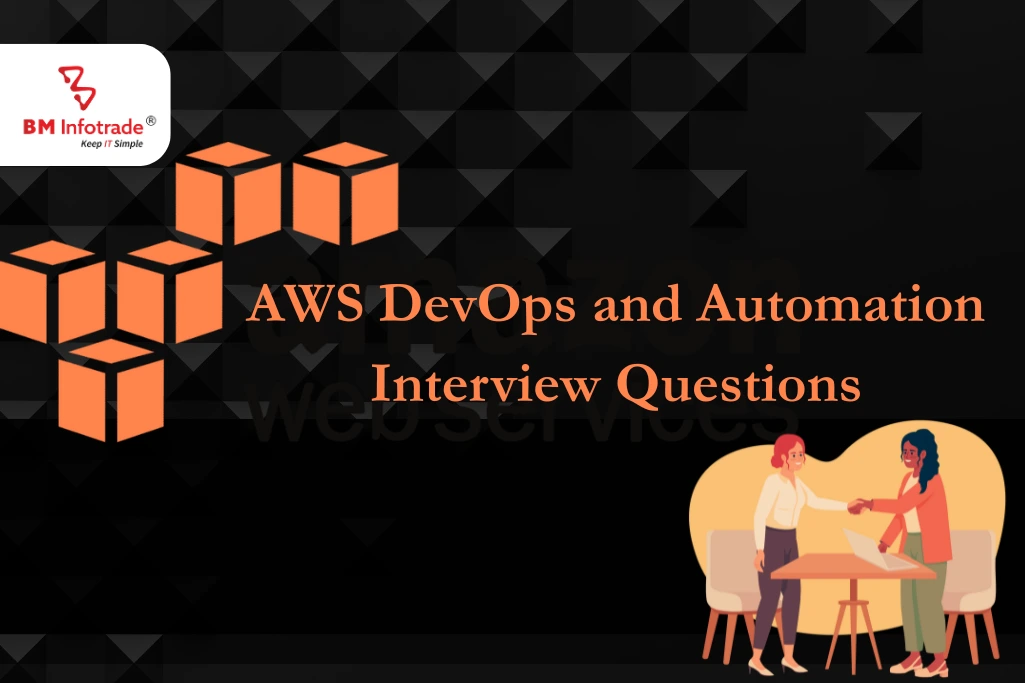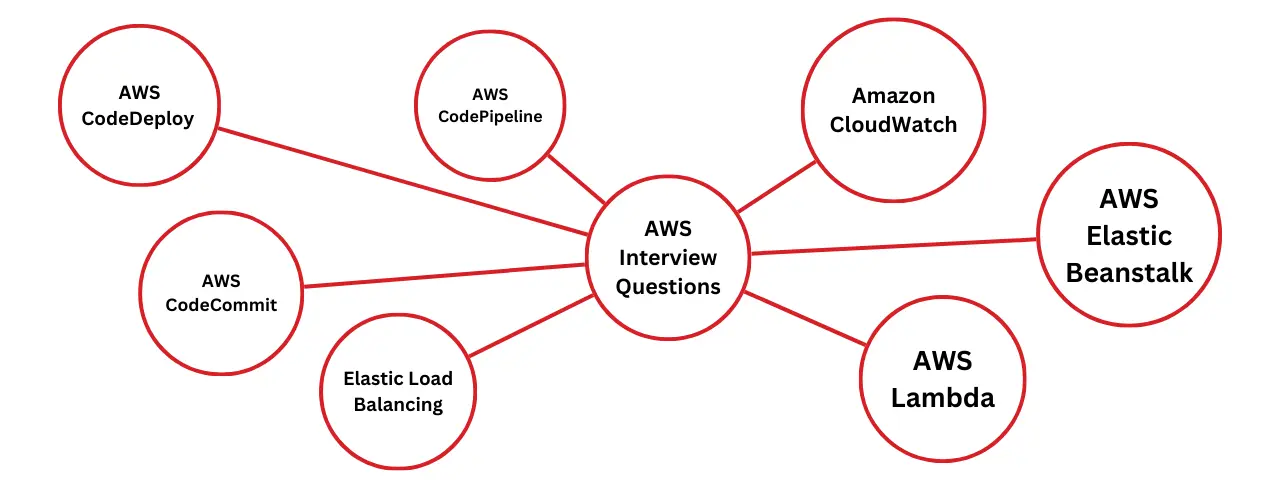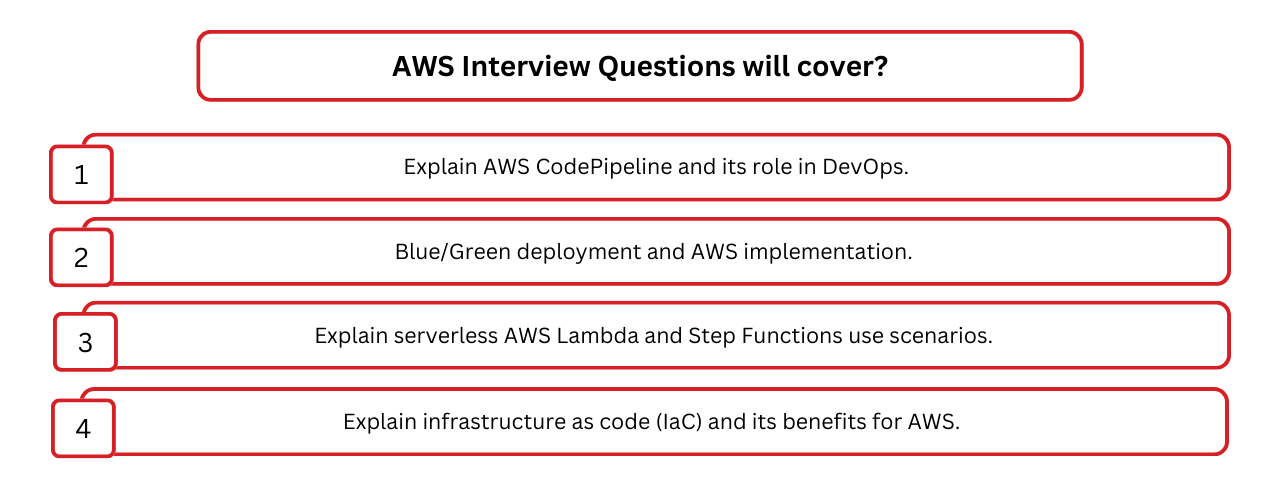AWS DevOps and Automation Interview Questions
Our AWS interview questions include infrastructure as code (IaC), continuous integration and delivery (CI/CD), monitoring and logging, security best practices.

AWS DevOps and Automation Interview Questions
Table of Contents
- AWS Interview Questions:
- Explain AWS CodePipeline and its role in DevOps.
- Blue/Green deployment and AWS implementation.
- Explain serverless AWS Lambda and Step Functions use scenarios.
- Explain the difference between resource-based and AWS IAM policies.
- Explain infrastructure as code (IaC) and its benefits for AWS.
- Give an example of how AWS services optimised DevOps expenses.
- Questions and answers on scenarios and problems
- Conclusion
Amazon Web Services (AWS) leads the cloud computing revolution by offering a broad range of cloud services to businesses worldwide. With its massive infrastructure and platform solutions, AWS helps numerous companies innovate, expand, and optimise operations. Thus, DevOps engineers and cloud architects need AWS capabilities.
AWS Interview Questions:
In this competitive market, AWS interviews need extensive knowledge of AWS services, best practices, and cloud technologies. Employers want candidates who can install, administer, and optimise AWS resources and use DevOps to improve development and operations. Our AWS interview questions include infrastructure as code (IaC), continuous integration and delivery (CI/CD), monitoring and logging, security best practices, and serverless architectures to help you succeed. By studying these questions and answers, you'll be better prepared to exhibit your skills in the interview, increasing your chances of landing your ideal cloud computing job.

Read More:- AWS Features and Pricing in 2025: A Detailed Guide for Businesses
Explain AWS CodePipeline and its role in DevOps.
AWS CodePipeline automates release build, test, and deploy. Simulation and automation of software release methods are possible. CodePipeline in DevOps lets developers quickly and reliably deliver code changes from source code repository to production.
What are AWS CloudFormation's infrastructure as code (IaC) benefits?
- Use code to deploy and manage AWS infrastructure resources using Infrastructure as Code (IaC).
- CloudFormation templates allow infrastructure specification versioning, consistency, and repeatability.
- Automating infrastructure provisioning and upgrading reduces human mistakes.
- CloudFormation stacks are easy to reproduce in development, testing, and production.
- It easily integrates with other AWS services to manage complex infrastructures.
What distinguishes AWS CodeDeploy from AWS CodeCommit and AWS CodePipeline?
- Developers may securely save and manage their source code with AWS CodeCommit, like Git.
- CI/CD service AWS CodePipeline builds, tests, and deploys applications.
- Fast, dependable application deployment to EC2 instances, Lambda functions, and on-premises servers is automated via AWS CodeDeploy.
Explain how EC2 instances and AWS Lambda functions vary. When would you deploy one over the other?
- EC2 instances are provisionable and manageable virtual servers that provide you additional infrastructure control and workload flexibility.
- AWS Lambda enables serverless computing by uploading code and growing the infrastructure automatically.
- Lambda functions are best for event-driven, short-lived jobs with intermittent consumption patterns, whereas EC2 instances are best for long-running applications, legacy systems, or workloads needing precise settings.

Blue/Green deployment and AWS implementation.
- Blue/Green deployment involves maintaining two identical production environments, one active (Blue) and one dormant (Green).
- Testing and validation of the new application occur in the inactive environment (Green).
- Traffic is directed from the active (Blue) to the newly deployed (Green) environments after validation, minimising downtime and risk.
- Elastic Load Balancing (ELB) for traffic routing, Auto Scaling for instance capacity management, and AWS CodeDeploy for automated deployments enable Blue/Green deployment in AWS.
How can AWS environments be monitored and logged with Amazon CloudWatch?
- To monitor AWS resources and applications, Amazon CloudWatch uses metrics, logs, and events.
- It checks AWS resource performance in real time, triggers alarms, and automates actions based on criteria.
- CloudWatch Logs centralises and analyses AWS resource and application log data to help you diagnose and understand system behaviour.
How would you automate AWS application deployment?
- We can automate application deployment with AWS CodePipeline, CodeBuild, and CodeDeploy.
- Create a CodePipeline pipeline for project development, testing, and deployment.
- CodeBuild compiles, tests, and generates deployment artefacts.
- Automate application changes to EC2 instances, Lambda functions, and other destinations using CodeDeploy.
What are the best DevOps AWS resource security practices?
- Grant just essential rights to users and resources to implement least privilege.
- Securely control AWS resource access with AWS IAM.
- Enable MFA for IAM users to increase security.
- Use AWS KMS and SSL/TLS to encrypt data at rest and in transit.
- Regularly audit security setups and monitor security incidents with AWS CloudTrail and GuardDuty.
Read More:- Mastering Your Azure Interview: Essential Questions
How to automatically grow AWS resources on demand?
- On demand, AWS Auto Scaling may modify the capacity of EC2 instances, ECS jobs, DynamoDB tables, and other AWS resources.
- Configure scaling policies to establish CPU utilisation and request count triggers and scaling actions to dynamically add or remove instances.
- Use AWS Application Auto Scaling to scale ECS services and Lambda functions that AWS Auto Scaling cannot.
How can AWS Elastic Beanstalk ease app deployment and management?
- PaaS AWS Elastic Beanstalk streamlines web application and service deployment, scalability, and administration.
- EC2 instances, load balancers, and databases are automatically provisioned based on your application's needs.
- Developers can focus on code rather than infrastructure with Elastic Beanstalk's multi-language and framework support.
- Its built-in monitoring, logging, and auto-scaling make scaling programmes easy.
Explain serverless AWS Lambda and Step Functions use scenarios.
- AWS Lambda is perfect for short-lived, event-driven functions triggered by HTTP requests, S3 events, DynamoDB changes, and scheduled events.
- Lambda is used for data processing, real-time file processing, IoT data intake, and backend API development.
- AWS Step Functions coordinate, error-handle, and maintain state across numerous AWS Lambda functions and other services in complicated processes.
- Step Functions automates workflows, manages business processes, and orchestrates microservices in serverless architectures.
Explain the difference between resource-based and AWS IAM policies.
- IAM policies specify AWS resource access rights for IAM identities (users, groups, roles).
- AWS resources like S3 buckets and Lambda functions have JSON rules that control who may access and use them.
- IAM policies provide rights to users and roles, whereas resource-based policies limit resource access.
AWS secrets and sensitive data: how would you handle them?
- Protect database credentials, API keys, and encryption keys with AWS Secrets Manager or Systems Manager Parameter Store.
- AWS KMS encrypts sensitive data at rest and in transit.
- Grant sensitive information access using access control and least privilege best practices.
- Protect sensitive data with application-level encryption and access restrictions.
How can AWS CloudFormation change sets assist manage infrastructure changes safely?
- AWS CloudFormation change sets let you test infrastructure changes before implementing them.
- Create a change set to compare the present and proposed CloudFormation stack modifications when updating it.
- Change sets allow you to examine and approve changes safely before deploying them to production settings.
What is AWS OpsWorks and how does it compare to Elastic Beanstalk?
- Using Chef or Puppet, AWS OpsWorks streamlines application and infrastructure deployment and administration.
- OpsWorks controls infrastructure setup and lifecycle management better than Elastic Beanstalk.
- AWS Elastic Beanstalk abstracts infrastructure administration to simplify web application and service deployment.
How would you construct an AWS application disaster recovery plan?
- Find application dependencies such databases, storage, compute instances, and networking.
- Data replication and backup enhance data durability and availability in case of failure.
- Use Amazon Route 53, Elastic Load Balancing, and Lambda for DNS failover, traffic routing, and automated recovery.
- Regular testing should identify gaps and flaws in the disaster recovery strategy.
Explain infrastructure as code (IaC) and its benefits for AWS.
- Infrastructure as Code lets you manage and offer infrastructure using machine-readable code.
- Use declarative templates like AWS CloudFormation or Terraform to define and configure AWS resources using IaC.
- IaC automates infrastructure provisioning and administration, provides consistency, repeatability, and version control.
How can you automate AWS resource and application testing?
- Create IaC templates and automate test environment provisioning with AWS CloudFormation.
- AWS CodeBuild, AWS CodePipeline, or Jenkins can execute unit, integration, and end-to-end tests.
- Test Lambda functions or serverless apps in reaction to events using AWS Lambda.
How can automation and management be done using AWS Systems Manager?
- Automate operational operations and centrally control AWS resources using AWS Systems Manager.
- Inventory, patching, configuration, automation, and parameter management are supported.
- Systems Manager Automation lets you build workflows and automate actions across different AWS services and resources, simplifying operations and eliminating manual involvement.
Give an example of how AWS services optimised DevOps expenses.
- You may explain how you used AWS Auto Scaling to automatically alter EC2 instance capacity depending on demand to minimise overprovisioning and save money.
- Another option is to use AWS Cost Explorer and AWS Budgets to track resource utilisation, discover cost patterns, and set budget thresholds to manage expenditure.
- You might also mention how you used AWS Spot or Reserved Instances to save money on non-production workloads or long-running apps.
Questions and answers on scenarios and problems
Question:
You manage an AWS-hosted e-commerce application as a DevOps team. Recent complaints indicate increasing latency and downtime during high usage. How would you investigate and fix this?
Answer:
CPU, memory, and network activity using AWS CloudWatch. Find latency and downtime trends in CloudWatch logs and analytics.
Performance Optimisation: Examine application and infrastructure architecture and settings. Reduce latency via optimizing resource allocation, horizontal scalability, and caching.
Load Testing: AWS LoadRunner and Apache JMeter can simulate heavy traffic scenarios and detect performance problems. Review the results to identify areas for improvement.
Infrastructure Scaling: Assess the application's infrastructure components such as EC2 instances, RDS databases, and load balancers. Adjust resources vertically or horizontally to meet demand.
Continuous Improvement: Use monitoring and optimisation to detect and fix performance issues. To maintain e-commerce application dependability and scalability, monitor changes and optimize.
Question:
You must build an AWS essential application disaster recovery (DR) plan. How would you design a robust DR solution with high availability and data integrity?
Answer:
Multi-region architecture with AWS services would help me create a solid AWS Disaster Recovery (DR) strategy with high availability and data integrity. First, I'd replicate essential data and resources across geographically distant AWS Regions to mitigate regional failures. Next, I'd automate DNS and database failover with Amazon Route 53 and Amazon RDS Multi-AZ installations. I would also use AWS Backup for automatic data backups and versioning to ensure data integrity and compliance. Continuous monitoring and testing of the DR configuration are necessary to ensure preparedness and optimise recovery time. The DR strategy would offer seamless failover, high availability, and data integrity during interruptions with these approaches.
Question:
On AWS, your team is moving a monolithic application to microservices. How would you migrate to minimise interruption and maximise microservices benefits?
Answer:
A staged strategy will minimise disruption and maximise advantages while migrating a monolithic application to AWS microservices.
Microservices would be created by identifying and decoupling monolith components. Since these microservices would be created and delivered separately, we could gradually replace monolith components.
The microservices would be containerised using AWS ECS or EKS for scalability and isolation. CI/CD pipelines automate testing and deployment, ensuring seamless transitions.
We would also use API gateways and service discovery to control microservice-client connectivity. Real-time performance monitoring and troubleshooting would use Amazon CloudWatch.
This stepwise approach minimises application disturbance while achieving microservices architecture's scalability, flexibility, and maintainability benefits.
Read More:- AWS DevOps and Automation Interview Questions
Conclusion
In conclusion, DevOps and automation in the AWS ecosystem includes many services, methods, and ideas that streamline software delivery, operational efficiency, and resource utilisation. The AWS interview questions included infrastructure as code (IaC), continuous integration and delivery (CI/CD), monitoring and logging, security best practices, serverless architectures, and cost optimisation tactics.
AWS supports DevOps and digital transformation via collaboration, automation, continuous integration, continuous deployment, and infrastructure as code. Companies may automate regular processes, streamline release pipelines, and extend infrastructure on-demand using AWS CodePipeline, CodeDeploy, Amazon ECS, and AWS Lambda to meet changing business needs.
AWS interview questions help interviewees and interviewers explore basic ideas, best practices, and real-world scenarios. Candidates may demonstrate AWS application architecture, deployment, and administration, problem-solving, and practical experience.





![Cloud Licensing and Compliance Made Easy [All-in-One Bundle]](https://bminfotrade.com/assets/upload/blog/21851766642757.png)

Anshul Goyal
Group BDM at B M Infotrade | 11+ years Experience | Business Consultancy | Providing solutions in Cyber Security, Data Analytics, Cloud Computing, Digitization, Data and AI | IT Sales Leader